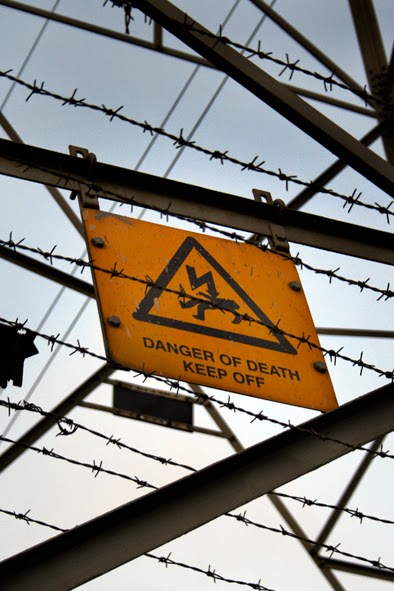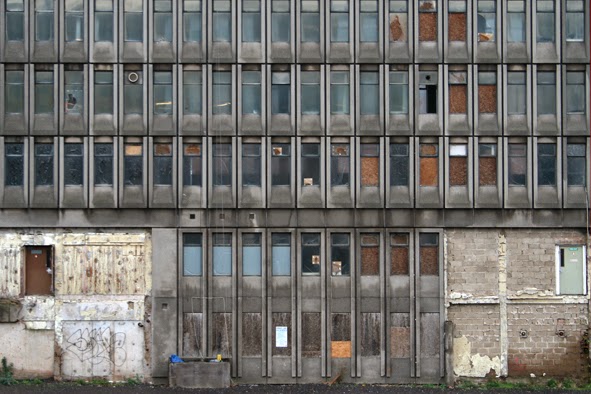 |
| Crown House, Central Leicester, November 2014 |
All that crumbling concrete
and haunted Modernism in my last post is just too delicious, so here are a few
more images from the same shooting location. Some of
these are a little more oblique or formally self-conscious and, as with so much
of what I do, there’s that love of the atmospheres, surfaces and materiality of
my urban surroundings.
 |
| Multi-Story Car Park, Lee Circle, Central Leicester, November 2014 |
The images here all derive
from my ongoing quest for locations for my concrete-themed video collaboration
with Andrew Smith. How much of this
footage will find it’s way into our final effort is impossible to predict, but
I’m massively enjoying just getting out there with the video camera and bagging
such subjects, wherever I find them. I’m
conscious that, around the turn of the year, we’ll need to harden down, both
thematically and editorially, and I’m sure that will be when the real work (and
learning) really starts. The aim is to
have something coherent to show at our ‘Mental
Mapping’ exhibition at Rugby Art Gallery & Museum, next June.
For now though, it’s still
about the sheer pleasure of getting out there and hunting down the raw imagery,
despite the drawbacks of plunging temperatures and ever-diminishing light
levels. Increasingly, I’ve found myself
wandering out of mic range with the DSLR to collect static shots at the same
time, leaving the movie camera to get on with it, when appropriate.
 |
| Multi-Story Car Park, Lee Circle, Central Leicester, October 2014 |
For this shoot, I based
myself in Leicester’s Lee Circle multi-story car park, - an edifice whose wider
significance I touched on last time.
Fairly early on a Saturday morning, I had the deserted upper decks to
myself and was clearly of insufficient interest to Security for them to inquire
about my (plainly benign) activities [1.].
 |
| Multi-Story Car Park, Lee Circle, Central Leicester, November 2014 |
The car park structure is of
obvious appeal as a subject in its own right, and it was fascinating to be able
to catalogue those interior spaces in their abandonment, whilst conscious of
the building slowly filling up with vehicles from below like an encroaching
tide. This was conveyed through the
ever-increasing volume of sound events drifting up the building’s ramps and
central well, and also through the quality of vibrations transmitted through
different parts of the physical structure.
A certain multi-sensory heightening is one of the notable features of
this steady-gaze approach to filming and I’ve never once become bored, as I’ve
allowed the true experiential dimensions of such places to unfold, as my static
lens records minimal ‘action’ in real time [2.]. Increasingly, I seem to
find ever more captivating layers of stimulus in locations that so many others
seem to keen to disregard, despise, or escape from as rapidly as possible.
 |
| Crown House From Lee Circle Car Park |
The other point about the car
park is that it provides an admirable vantage point from which to survey other
notable and related landmarks. Prime
amongst these is the abandoned, and increasingly derelict, Crown House, just across
the road. This sublimely ugly monolith
is rapidly becoming a bona fide modern ruin, - a state that often presages
imminent demolition. Interestingly, the
plot immediately in front of the building was temporarily used as an impromptu
car park until recently. My interest in
urban car parks sometimes feels perplexingly nerdish [3.], but I can’t help musing on the differences between the
contemporary organic opportunism of today, and the very conscious planning of
the 1960s temple to parking opposite.
 |
| This One Speaks For Itself, Doesn't It? |
 |
| Lee Circle, Central Leicester, October 2014 |
I don’t know what the plans
are for Crown House, (although the hoardings around what is now an exclusion
zone, don’t bode well). For now, I must
confess, it fascinates me in its decaying state far more than when in use. The view from the car park allowed me to
document the rich textural interest now evident at ground level, where certain
sections have already been removed, and the increasing variation in the strict
grid of its façade, - created as windows are gradually broken or boarded up.
 |
| Crown House, Central Leicester, November 2014 |
Beyond the Multi-Story, on
the other side of Lee Circle, lies a rather beautiful building that once housed
Leicester’s main Telephone Exchange.
This is an example of a lighter, earlier tradition of Modernism than the
sullen Brutalism of Crown House. It
displays the influence of Scandinavian design and a hint of the ocean liner or
seaside aesthetic that once reflected a more pleasure-seeking aspect of
Modernism. This is reinforced by the
off-white paint that coats its concrete.
That paint is fairly clean, and the building well maintained, having
been redeveloped as an apartment block in recent years. In that respect, it represents somewhat
misplaced, pre-recession attempts to gentrify a neighbourhood that, for now, remains
resolutely down-at-heel.
 |
| Redeveloped Telephone Exchange, Lee Circle, Central Leicester, November 2014 |
A couple of other notable,
slightly more distant landmarks caught my eye in passing, as I looked out from
Lee Circle Car Park. One is the
impassive, slab-sided stump of The Cardinal Exchange Tower, - another telecoms-related
building that, I assume, replaced the earlier exchange as the telephone network
expanded. It’s closer to Crown House in
its stern aesthetic, and even taller, remaining a powerful presence on the
Leicester skyline.
 |
Redeveloped Telephone Exchange, With Newer Cardinal Exchange Tower Beyond,
Central Leicester, November 2014 |
Of rather more ruin appeal is
another, slightly alarming multi-story car park edifice, situated a little to
the north east of Lee Circle, between Abbey Street and Garden Street. If the aesthetics of Lee Circle divide
opinion, it’s probably fair to say only an architect’s mother could have loved
this one - even in the 1960s. It’s
another example of how central the car was to the thinking of urban planners of
the period, this time featuring a hotel (most recently, the Sky Plaza), perched
inelegantly on top of a distinctly rickety looking multi-deck parking structure. It’s been empty since a fire in 2012, but is
clearly visited in its increasingly disheveled, current incarnation by Urban Explorers and Graffiti Writers.
 |
| Sky Plaza Hotel & Car Park Building, Central Leicester, November 2014 |
Looking out from Lee Circle,
towards the Sky Plaza building, you can almost sense the two monuments to a
past era speak to each other of lost optimism across the intervening rooftops
of a more disappointed age. With my
fantasy head on, the Sky Plaza building even feels a little like some
post-apocalyptic rampart, - rising from a decaying cityscape. Re-imagined in a suitable dystopian SF novel or film, it
might be peopled by refugees, survivalists, anarchists, mutants, or who knows
what?
 |
| Multi-Story Car Park, Lee Circle, Central Leicester, November 2014 |
[1.]: I’ve lost count of how many times this has
happened as I’ve been out and about with my cameras, in locations clearly not
commonly regarded as standard photographic subject matter. Most recently, two Police Officers
interrupted me; keen to know why I was filming in a desolate Leicester
underpass. In fairness, they were nice
as pie and professed to be merely intrigued.
Generally, I find that claiming to be “An Artist, - recording my surroundings”, satisfies both authority
figures and curious members of the public, who (I imagine) probably go on their
way convinced they’ve just encountered a harmless nutter.
[2.]: Of course, very few subjects can be said to
be completely static. One theme that has
already emerged, as I’ve filmed in various locations, is the wealth of nuances,
perceptual shifts, micro-actions and implied events that often reveal
themselves in nominally motionless, environmental subjects. Having got my eye (and ear) in, I often find
that the smallest movements, changes in illumination, fugitive cast shadows, or
passing sounds, begin to feel like major events.
[3.]: Does this make me a Nurb?















































